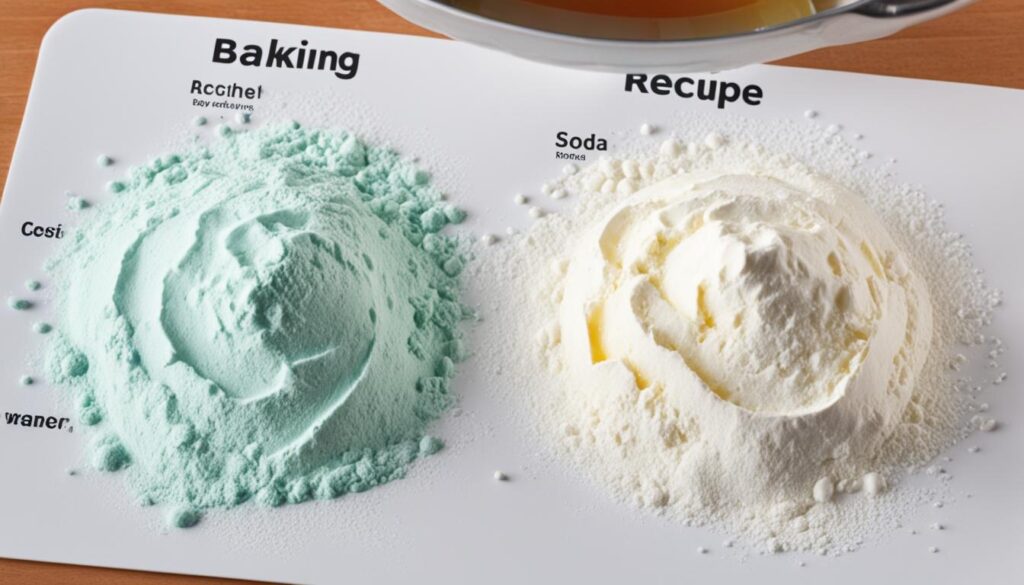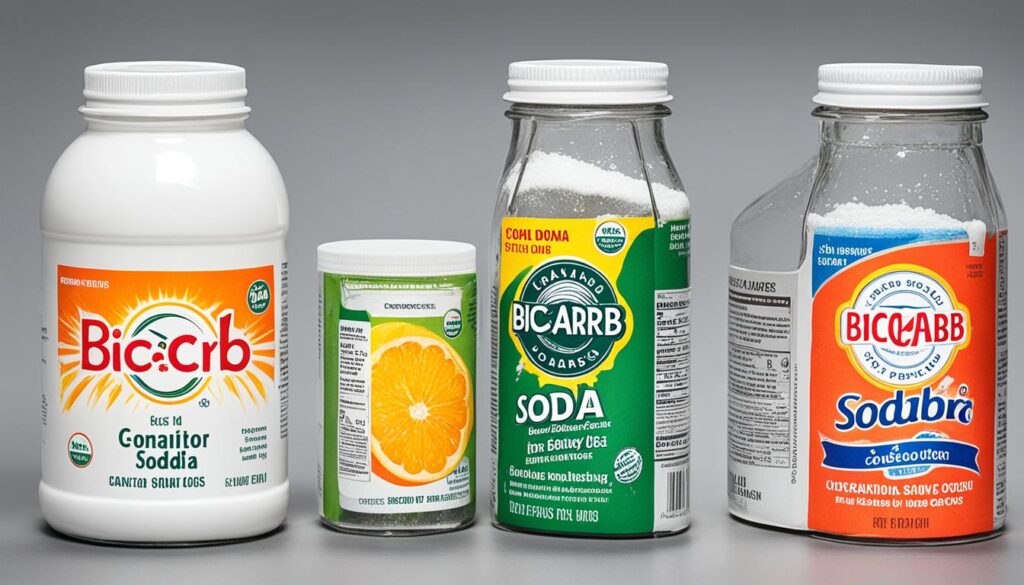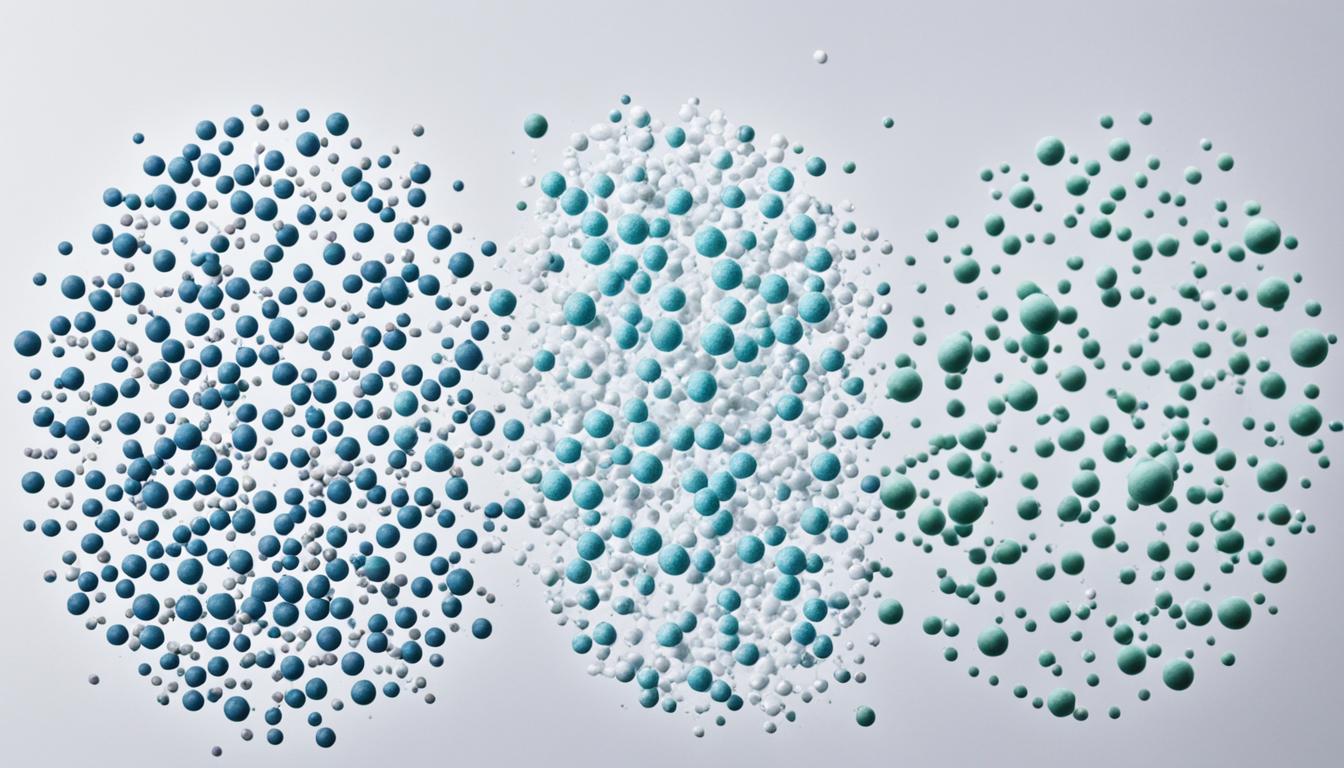Have you ever wondered if bi carb soda and baking soda are the same? Perhaps you’ve come across both terms and asked yourself, “What’s the difference?” Well, we’re here to clear up the confusion.
It turns out that bicarbonate of soda, commonly known as bi carb soda, and baking soda are indeed the same thing! These terms are used interchangeably in different countries. In Australia, New Zealand, and the UK, we refer to it as bi carb soda, while in the US, they call it baking soda. So whether you’re using bi carb soda or baking soda, you’re actually using the exact same ingredient.
But what exactly is bi carb soda? Let’s find out.
What is Bicarb Soda?
Bicarb soda, or bicarbonate of soda, is an alkaline leavening agent that plays a crucial role in the kitchen. When used in recipes that require the mixture of moisture and an acidic ingredient, such as lemon juice or buttermilk, it helps the batter rise and creates a light and fluffy texture. Bicarb soda is not limited to baking alone; it can also be used for polishing silverware and other cleaning purposes.
While using bicarb soda in your recipes, it’s important to sift it well to ensure that it is evenly distributed. This will help prevent any tangy flavor from being left behind in the final product.
Key Takeaways:
- Bi carb soda and baking soda are the same thing, just with different names used in different countries.
- Bicarb soda is an alkaline leavening agent used in recipes that require moisture and an acidic ingredient.
- Bicarb soda can also be used for cleaning purposes and polishing silverware.
- When using bicarb soda in recipes, make sure to sift it well to avoid any tangy flavors.
What is Bicarb Soda?
Bicarb soda, also known as bicarbonate of soda, is an alkaline leavening agent that plays a crucial role in various cooking and baking recipes. It shares a significant equivalency with baking soda, as the terms are often used interchangeably in different countries. For instance, in Australia, New Zealand, and the UK, it is commonly referred to as bi carb soda, while in the US, it is predominantly known as baking soda.
In cooking and baking, bicarb soda is primarily utilized in recipes that require the mixture of moisture and an acidic ingredient, such as lemon juice or buttermilk. The combination of these components triggers a chemical reaction that results in the batter rising and creating a light and fluffy texture. Moreover, bicarb soda can also be employed for non-culinary purposes, such as polishing silverware.
When incorporating bicarb soda into recipes, it is important to ensure it is sifted well beforehand. This process helps to prevent any lumps or clumps from forming and ensures more even distribution throughout the batter. Additionally, thorough sifting helps to alleviate the possibility of leaving a tangy or unpleasant flavor in the final product.
Key Points:
- Bicarb soda is an alkaline leavening agent used in cooking and baking.
- It can be used interchangeably with baking soda, with different names in different countries.
- Bicarb soda is commonly used with acidic ingredients to make the batter rise.
- It should be sifted well before use to avoid leaving a tangy flavor.
What is Baking Powder?
Baking powder is a versatile leavening agent commonly used in baking. It is a combination of bicarb soda and a dry acidic ingredient, such as cream of tartar. Baking powder also contains a starch, usually cornstarch, to absorb moisture and prevent clumping. The interaction between the acidic component and the bicarb soda creates carbon dioxide gas, causing the dough or batter to rise.
Baking powder is particularly useful in recipes that do not include an acidic ingredient. Unlike baking soda, which requires an acid to activate its leavening properties, baking powder can react with moisture alone. This makes it an ideal leavening agent for recipes such as cakes, cookies, and quick breads that do not have naturally acidic components.
When substituting baking powder for baking soda, it’s important to adjust the conversion ratio. Baking powder is less potent than baking soda, so a larger quantity is required to achieve the same leavening effect. As a general guideline, for every teaspoon of baking powder, you’ll need to use around one-quarter teaspoon of baking soda.
Here’s a conversion table to help you substitute baking powder with baking soda:
| Baking Powder (teaspoons) | Baking Soda (teaspoons) |
|---|---|
| 1 | 1/4 |
| 2 | 1/2 |
| 3 | 3/4 |
| 4 | 1 |
Remember to adjust the recipe accordingly when substituting baking powder with baking soda by adding an acidic ingredient, such as lemon juice or vinegar, to maintain the balance of flavors. It’s always a good idea to test the freshness of your baking powder and baking soda before using them in your recipes. Fresh leavening agents ensure optimal results, with light and fluffy baked goods.
Can Bicarb Soda Be Used Instead of Baking Powder?
While baking powder and bicarb soda may seem similar, there are a few key differences between the two. However, you can still use bicarb soda as a substitute for baking powder by making a few adjustments to your recipe.
Bicarb soda is stronger than baking powder, so you’ll need to account for its potency. When substituting bicarb soda for baking powder, use half the amount of bicarb soda that the recipe calls for baking powder. For example, if the recipe calls for 1 teaspoon of baking powder, you’ll need to use just 1/2 teaspoon of bicarb soda.
Since bicarb soda requires an acidic ingredient to activate its leavening properties, you’ll also need to increase the amount of acidic ingredients in your recipe. You can add an additional acidic ingredient, such as lemon juice or vinegar, to help balance the flavors and ensure the proper rise of your baked goods.
It’s important to note that the strength of bicarb soda may vary depending on the brand, so you may need to adjust the amount used accordingly.
Comparison Table: Bicarb Soda vs. Baking Powder
| Bicarb Soda | Baking Powder |
|---|---|
| Stronger | Milder |
| Requires acidic ingredient | Contains its own acidic component |
| Used in quick recipes | Used in recipes without acidic components |
| Requires adjustment in recipe | Can be used as-is |
By following these adjustments, you can successfully use bicarb soda instead of baking powder in your recipes. Just remember to adjust the amounts and add extra acidity to ensure the desired outcomes.
Remember, experimentation is key when it comes to baking, so don’t be afraid to try different ratios and techniques to achieve the best results with bicarb soda as a baking powder substitute.
Testing the Freshness of Baking Powder and Bicarb Soda
Ensuring the freshness of your baking powder and bicarb soda is essential for achieving the best results in your baking endeavors. In this section, we will discuss simple and reliable methods to test if your baking powder and bicarb soda are still good to use.
Testing Baking Powder
To test the freshness of your baking powder, gather a small amount and place it in a bowl. Next, pour boiling water over the baking powder and observe its reaction. If the baking powder starts to foam and bubble, it is still good to use. The foaming action indicates that the baking powder is active and will effectively leaven your baked goods.
It’s important to note that testing baking powder with boiling water is an accurate method because the high temperature aids in releasing the gas-producing properties of the baking powder. This process helps to determine its freshness and effectiveness in your recipes.
Testing Bicarb Soda
Testing the freshness of bicarb soda is a straightforward process that requires vinegar or lemon juice. Start by placing a small amount of bicarb soda in a bowl. Next, add a few drops of vinegar or lemon juice to the bicarb soda and observe the reaction. If the mixture starts to bubble and fizz, it indicates that the bicarb soda is still good to use as a leavening agent in your recipes.
This simple test works because the acidic nature of vinegar or lemon juice reacts with bicarb soda, creating carbon dioxide gas and causing the bubbling effect. If there is no reaction, it may be an indication that the bicarb soda has lost its potency and should be replaced for optimal baking results.
Here’s a visual representation of the testing process:
| Leavening Agent | Test Method | Result |
|---|---|---|
| Baking Powder | Mix with boiling water | If it foams up, it is still good to use |
| Bicarb Soda | Add to vinegar or lemon juice | If it bubbles, it is still good to use |
Baking Soda and Baking Powder Conversions
When it comes to substituting ingredients in baking, it’s important to have the correct conversion ratios in order to achieve the desired results. In the case of baking soda and baking powder, the conversion ratios differ depending on which ingredient you are substituting.
When substituting baking soda for baking powder, the conversion ratio is 1:4. This means that for every teaspoon of baking powder called for in a recipe, you would need 1/4 teaspoon of baking soda. It’s important to note that when using baking soda as a substitute, you also need to compensate for the missing acidic component that baking powder provides. To do this, you can add an additional acid, such as lemon juice or vinegar, to the recipe to help balance the flavors.
On the other hand, when converting from baking soda to baking powder, the ratio is the opposite, with a conversion ratio of 4:1. This means that for every teaspoon of baking soda called for in a recipe, you would need 4 teaspoons of baking powder. This conversion ratio takes into account the different strengths of the two ingredients.
To help illustrate these conversion ratios, here is a simple table:
| Baking Powder | Baking Soda |
|---|---|
| 1 teaspoon | 1/4 teaspoon |
| 2 teaspoons | 1/2 teaspoon |
| 3 teaspoons | 3/4 teaspoon |
| 4 teaspoons | 1 teaspoon |
Remember, accurate measurements are key when substituting baking soda and baking powder to ensure the proper leavening of your baked goods. Don’t forget to adjust for the missing acidic component when using baking soda as a substitute for baking powder, and vice versa.

Difference Between Baking Soda and Baking Powder
Baking soda and baking powder are essential leavening agents used in baking. Although they serve a similar purpose, there are distinct differences between the two.
Baking soda: Also known as sodium bicarbonate, baking soda requires the presence of an acidic ingredient in the recipe to trigger a reaction. Once combined with an acid such as lemon juice, buttermilk, or vinegar, baking soda produces carbon dioxide bubbles, causing the dough or batter to rise.
Baking powder: In contrast, baking powder already contains both an acidic component and a base (such as bicarbonate of soda) in a balanced form. It reacts with moisture alone, producing carbon dioxide bubbles, resulting in the expansion and leavening of the dough or batter.
Baking powder also includes a starch, such as cornstarch or potato starch, which absorbs moisture and prevents premature activation of the acidic and basic components. This starch ensures that the leavening reaction occurs primarily during baking, rather than during preparation.
To sum it up, the main difference between baking soda and baking powder lies in the need for an acidic ingredient. Baking soda requires an external acidic component, while baking powder already contains its own acidic component, making it a more convenient option.
“Baking soda requires an acidic ingredient to create a leavening reaction, whereas baking powder already has an acidic component and can react with moisture alone.”
| Baking Soda | Baking Powder |
|---|---|
| Requires an acidic ingredient to create a reaction | Contains an acidic component and a base |
| Produces carbon dioxide when combined with acid | Produces carbon dioxide when moistened |
| Requires careful measurement and adjustment for proper leavening | Ready to use; already balanced |
| No starch content | Contains a starch to regulate reaction timing |
Understanding the difference between baking soda and baking powder is crucial in baking, as it affects the overall outcome of your recipes. Whether you need an acidic component or prefer the convenience of an all-in-one leavening agent, choosing the right ingredient will ensure the success of your baked goods.
Baking Soda and Baking Powder Uses
Bicarb soda (also known as baking soda) and baking powder have distinct uses in the world of baking. Understanding when and how to use each can help ensure successful baking results.
Bicarb Soda (Baking Soda) Uses
Bicarb soda is commonly used in recipes that require an acidic ingredient to activate the leavening process. When combined with moisture and an acid, such as lemon juice or buttermilk, bicarb soda produces carbon dioxide gas bubbles, causing the batter to rise. It is frequently used in quick recipes like biscuits or breads, where a swift and reliable rise is necessary.
Baking Powder Uses
Baking powder, on the other hand, is a complete leavening agent that does not require an acidic component in the recipe. It already contains an acidic ingredient, typically cream of tartar, allowing it to react with moisture alone. Baking powder is widely used in recipes for cakes, cookies, and quick breads, where a more extended rise time is desirable. Its all-in-one composition eliminates the need for additional acidic ingredients and simplifies the baking process.

Both bicarb soda and baking powder have their place in the kitchen, but substituting one for the other can alter the outcome of a recipe. It is essential to understand the differences and use the appropriate leavening agent for your specific baking needs.
Baking Soda and Baking Powder in Different Countries
The terms for bi carb soda and baking soda vary across different countries. In Australia, New Zealand, and the UK, it is commonly referred to as bi carb soda, while in the US, it is known as baking soda. Despite the difference in names, it is important to note that these substances are the same and can be used interchangeably in recipes.
Whether you’re following a recipe from a classic British cookbook or trying out a traditional American dish, you can rest assured that using bi carb soda or baking soda will achieve the desired results. The only thing that differs is the naming convention.
“The terms bi carb soda and baking soda refer to the same chemical compound, sodium bicarbonate. So, regardless of whether your recipe calls for bi carb soda or baking soda, you can use them interchangeably.”
In fact, this distinction is not unique to baking ingredients. There are many instances where different countries or regions have their own names for the same thing. For example, what Americans call “cilantro,” Australians refer to as “coriander.”
To avoid any confusion, it’s always a good idea to familiarize yourself with the local terminology when trying out international recipes. This way, you can easily find the right ingredients without any hiccups.
To summarize, while the names may vary, bi carb soda and baking soda are the same substance, sodium bicarbonate, and can be used interchangeably in recipes, no matter where you are in the world.
Conclusion
In conclusion, bi carb soda and baking soda are virtually the same product with different names used in different countries. While bi carb soda is the preferred term in Australia, New Zealand, and the UK, baking soda is commonly used in the US. They both serve as pure leavening agents, perfect for cooking and baking projects.
On the other hand, baking powder consists of a combination of bi carb soda, an acidic ingredient, and a starch. Baking powder is frequently used in recipes that do not contain an acidic component and require an all-in-one leavening agent.
However, if you find yourself without baking powder in your pantry, you can utilize bi carb soda as a substitute. Remember to make the necessary adjustments by halving the amount of bi carb soda and introducing an additional acidic component, such as lemon juice or vinegar, to balance the flavors.
Before using either baking powder or bi carb soda in your recipes, it’s essential to test their freshness. Mix baking powder with boiling water to determine if it foams up, indicating that it’s still good to use. As for bi carb soda, add a small amount to a bowl and pour vinegar or lemon juice over it. If it bubbles, it’s still fresh and can be used in your baking adventures.
Understanding the differences between these leavening agents and their uses is crucial for achieving the desired results in your baking endeavors. Whether you’re baking biscuits, cakes, or bread, knowing when to use bi carb soda, baking soda, or baking powder will help you create delicious treats every time.
